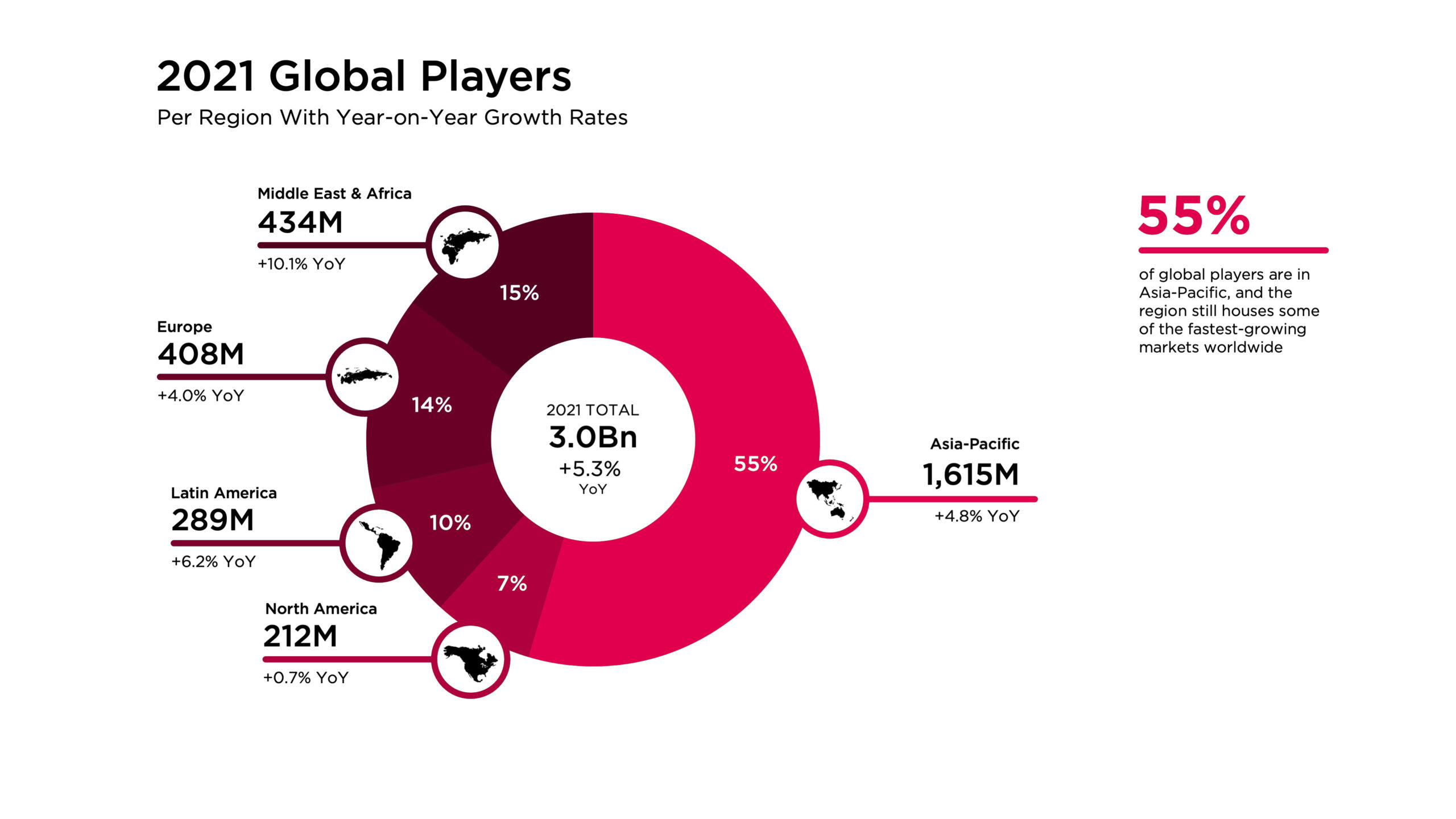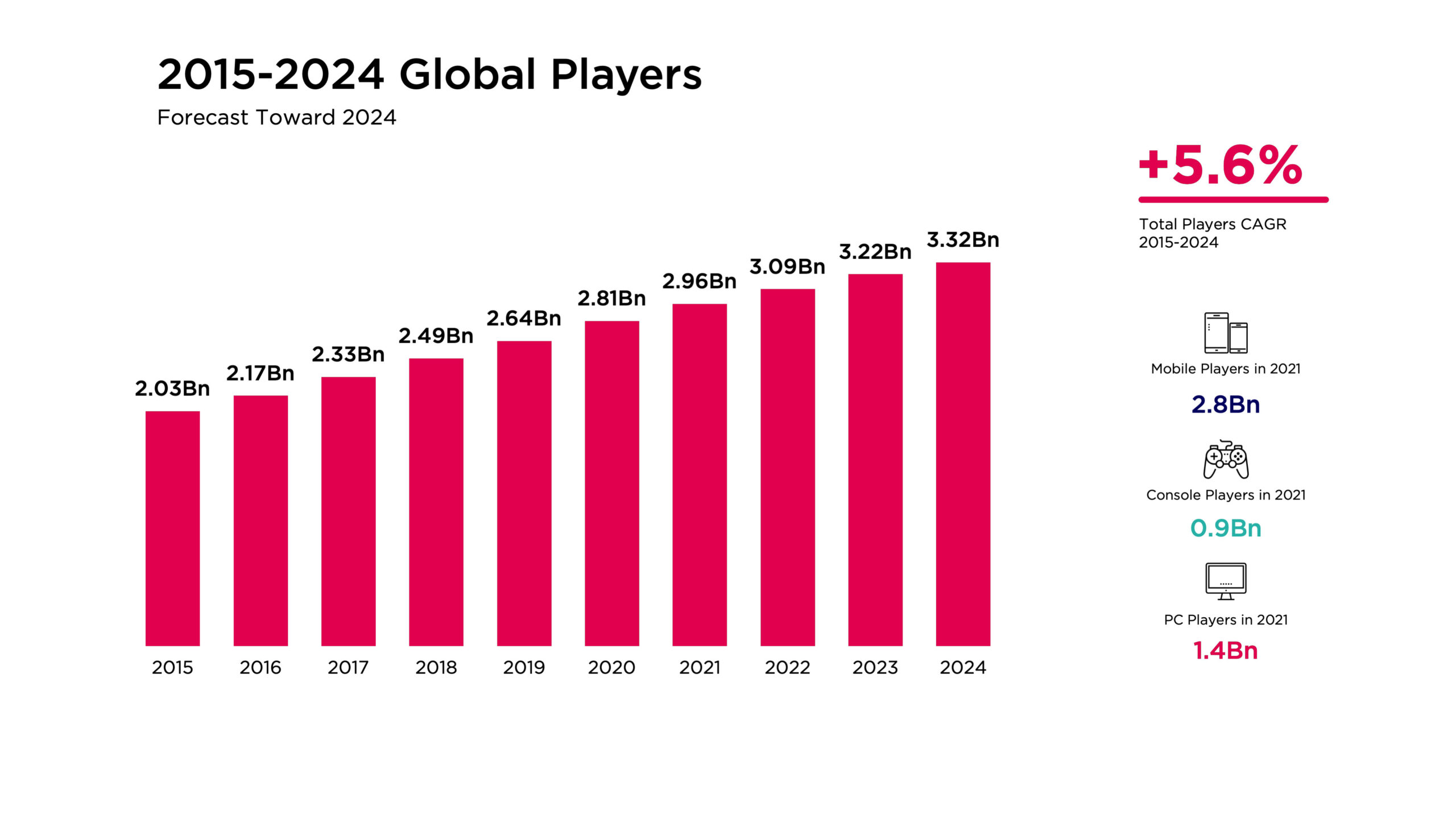A bright future for the gaming market: the number of players will grow above 3 billion by 2024 and annual revenues will exceed $ 200 billion!
Powered by nearly 3 billion players, the global gaming market will generate USD 175.8 billion from consumer spending in 2021, a slight decrease of 1.1% year on year. This decline is caused by the PC and console market, which according to Newzoo forecasts will drop by -2.8% year on year to USD 35.9 billion (PC) in 2021 and -8.9% to USD 49.2 billion (console). On the other hand, the mobile gaming market will generate USD 90.7 billion in consumer spending in 2021, an increase of 4.4% year on year. The long-term trajectory of the gaming market remains undeniably positive, but the market naturally cannot sustain the impressive growth recorded in 2020 for another year. The small fall this year is temporary.
Consumers driving the USD 176 billion gaming market
Ile osób gra w gry? mobilna konsola PCThe market will grow with a healthy CAGR (2019 to 2024) + 8.7% to reach $ 218.7 billion in 2024, surpassing the USD 200 billion threshold in 2023. Who are the nearly three billion players driving this buoyant market?
As you can see, the Asia-Pacific region is by far the largest player in the world (55% of the global number), which makes sense as the region is home to roughly the same percentage (54%) of the world population online. The high player share in the Asia-Pacific region is largely due to China’s huge population, but the region also includes growth regions such as India and Southeast Asia.

The revenues paint a different picture, however
Europe and North America are significantly re-indexing gamers’ spending, together accounting for over 40% of gaming revenue. Interestingly, these two markets serve less than a quarter of 2021 players worldwide (14% in Europe and 7% in North America).
Due to the maturity of the markets in these western regions, revenue growth within them is a key challenge for publishers. This revenue saturation is the reason why many established gaming companies in Europe and North America are increasingly turning their attention to the Middle East, African and Latin American markets.
These two regions are the fastest growing in the world in terms of the number of players. Like every year, the main drivers of player growth in Latin America, the Middle East and Africa are online population growth and improvement of internet infrastructure. Western developers are also looking at the Asia-Pacific markets with the greatest potential for similar reasons, including China, India and growth markets in Southeast Asia.
Over 90% of 2021 players play via mobile devices
Due to the Asia Pacific’s appetite for mobile gaming, as well as the segment’s availability and ubiquity in all markets, 2.8 billion of the 3 billion global players will play this year on a mobile device, compared to 1.4 billion on PC and 0.9 billion on consoles.
There are understandably plenty of crossovers here as more consumers than ever previously play in multiple segments. This is partly due to the ongoing trend of agnosticism platformer (blurring line between platforms), which in turn is driven by a cross-game.


Greater player growth is inevitable
Newzoo_Global_Player_Forecast_June2021 Czy liczba graczy rośnie?Player growth rates from 2020 to 2021 are already impressive (+ 5.4%), and many new players that enter the market during the pandemic will continue to spend money and engage in entertainment. Nevertheless, even more players will enter the market:
The image above shows an impressive nine-year growth trajectory for the player base from 2015, when the number of players was just over 2 billion, to the number of players in 2024 exceeding 3.3 billion.
From unprecedented M&A activity to tracking concerns: other trends driving today’s gaming market
With our focus on today’s gaming market, we expect trends such as the continual shifts in smartphone activity tracking and transmedia experiments on TV and movies to continue to flourish in the gaming
industry. Consolidation of publishers through mergers and acquisitions, continuous development in the field of crossplay agnosticism platforms and the challenges of store fees will also shake up the dynamics our exciting market.
Into the Metaverse: from fantasy science fiction to reality?
The pandemic caused the role of gaming to evolve quickly into something more meaningful than the entertainment medium. Games have become something of an extension of our world: a key social gathering place and a way to celebrate life’s events. Game worlds filled with digital avatars of self-expression enable communities to share a wealth of social, human experiences that are unattainable through other media. This development of online virtual worlds – and the activities within them – has caused waves of attention and investment around it, which is commonly referred to as the metaverse. „This future may be closer than we think, because the pandemic has accelerated our acceptance of spending more time in virtual worlds, and generation Z has already got used to using only digital technology”, says Sébastien Borget, COO of the Sandbox.
Often referred to as the next evolution of the Internet – or Web 3.0., Metaverse is likely to impact almost every industry in the future, going far beyond gaming. “We imagine that in the next 10 years, metaverse will profoundly change the way we think about how we will work, meet, play and earn money through economic and business opportunities and created workplaces”, says Borget. „If brands adopt the right approach to the new NFT medium, the connection between brands and fans in the metaworld could be closer than ever.”



